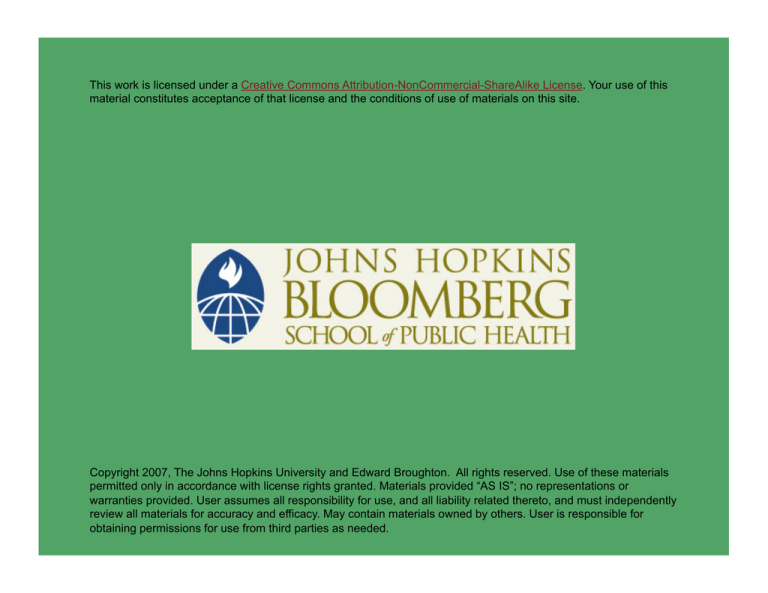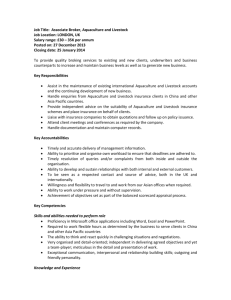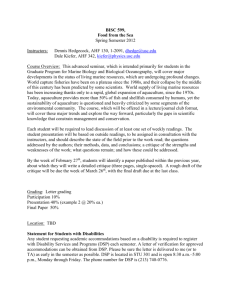
This work is licensed under a Creative Commons Attribution-NonCommercial-ShareAlike License. Your use of this
material constitutes acceptance of that license and the conditions of use of materials on this site.
Copyright 2007, The Johns Hopkins University and Edward Broughton. All rights reserved. Use of these materials
permitted only in accordance with license rights granted. Materials provided “AS IS”; no representations or
warranties provided. User assumes all responsibility for use, and all liability related thereto, and must independently
review all materials for accuracy and efficacy. May contain materials owned by others. User is responsible for
obtaining permissions for use from third parties as needed.
Public Health Implications of Aquaculture
Edward Broughton, MPH
Johns Hopkins University
Edward Broughton
Doctoral Student, Johns Hopkins School of
Public Health, Department of International
Health
Fellow, Center for a Livable Future
Interest in public health impacts of intensive
aquaculture
MS and faculty appointment, Columbia
University’s Mailman School of Public Health
3
Section A
Aquaculture: Introduction
Outline
What is industrial aquaculture?
What are the various types of aquaculture?
What are the trends in aquaculture production worldwide?
Similarities to industrial terrestrial animal agriculture
Image source: FAO.
5
Definitions
Aquaculture
- Farming of aquatic animals and plants in inland or coastal
waters or open ocean
- Intervention in the rearing process to enhance production
- Individual or corporate ownership of stock being cultivated
Source: FAO. The state of the world’s fisheries and aquaculture, 2006.
6
Definitions
Intensive aquaculture
- Facility production > 200 tons per hectare per year
- High degree of control
- High-tech and high cost
- Claims high production efficiencies
- More independent of local climate/water quality
7
Inland (Freshwater) Aquaculture
Freshwater species, mostly herbivorous
Carp, tilapia, catfish, trout, mollusks, crustaceans
Most production occurs in Asia
Some production in U.S., Southern Europe, Africa
Chinese carp farms
Image source: Environment and Development Challenges. Retrieved from www.edcnews.se/Research/Proteinprod.html
8
Marine (Saltwater) Aquaculture
Saltwater species, mostly carnivorous
Salmon, shrimp, mollusks
Most production in East Asia, Northern Europe, Chile, and Canada
Photo by yeraze via flickr.com. Creative Commons BY-NC.
Production Methods: Open System
Fish cages/net pens
No solid barrier between fish farm and natural environment
10
Production Methods: Open System
Fishmeal
Drugs and additives
Feces, waste
fishmeal, drugs
11
Production Methods: Closed System
Closed system
- Tanks or ponds separated from the natural environment with
solid barrier
- All or most water is filtered and recirculated
- Requires more technology inputs
12
Production Methods: Closed System
Effluent
Pond wastewater
Pump
Fish ponds
Filtration
unit
Recirculating water
13
Nature of Aquaculture Operations—1
Selective breeding for size, color, and rapid growth
Use of nonindigenous species
14
Nature of Aquaculture Operations—2
High density of livestock
- Stress decreases resistance
- Increases transmission of diseases
- Increases concentration of wastes
15
Nature of Aquaculture Operations—3
Use of aquafeed
- 5–7 pounds of fishmeal required for every 1 pound of fish
produced
- Additives include antibiotics and color-enhancing chemicals
Source: Pauly et al. (1998). Fishing down marine food webs. Science, 279, 5352, 860–863.
16
Nature of Aquaculture Operations—4
Highly contaminated effluents
- Fecal matter
- Veterinary drug residue
- Excess food/oil
- Heavy metals
Source: Pauly et al. (1998). Fishing down marine food webs. Science, 279, 5352, 860–863.
17
Nature of Aquaculture Operations—5
Farming up the food chain
Primary consumers
Higher-level carnivores
Aquatic plants/
phytoplankton
Source: Pauly et al. (1998). Fishing down marine food webs. Science, 279, 5352, 860–863. Seaweed by welshcathy via
flickr.com (Creative Commons BY-NC-ND); Catfish by wetwater via flickr.com (Creative Commons BY-NC-SA); Salmon by
Rob Casey via flickr.com (Creative Commons BY-NC-ND).
Nature of Aquaculture Operations—6
Fishing down the food chain
Tuna
Cod
Herring
Zooplankton
Phytoplankton
Source: Pauly et al. (1998). Fishing down marine food webs. Science, 279, 5352, 860–863. Tuna by Courtney Romann (BY-NCND); Cod by Gunnar Birgisson Powers (BY-NC-SA); Herring by Jorgen Schyberg (BY-NC-ND); Zooplankton by Paul Galipeau
(BY-NC); Phytoplankton by Seth Pipkin (BY-SA).
Global Trends in Aquaculture
Relative contribution of aquaculture and capture fisheries to fish
consumption
Source: FAO. The state of the world’s fisheries and aquaculture, 2006.
20
Global Trends in Aquaculture
Top 10 producers by
quantity, 2004
Annual
growth (%)
Top 10 producers by
growth, 2004
Annual
growth (%)
China
5.0
Burma
45.1
India
6.3
Vietnam
30.6
Vietnam
30.6
Turkey
24
Thailand
10.8
Netherlands
20.4
Indonesia
6.9
Republic of Korea
16.9
Bangladesh
7.8
Iran
16.5
Japan
-3.1
Egypt
11.9
Chile
11.2
Chile
11.2
Thailand
10.8
U.S.A.
10.4
Norway
7.7
U.S.A.
10.4
Source: FAO. The state of the world’s fisheries and aquaculture, 2006.
21
Global Trends in Aquaculture
Time period
Crustacean
Mollusks
Freshwater
fish
Diadromous
fish
Marine fish
Overall
1970–1980
23.9
5.6
6.0
6.5
14.1
6.2
1980–1990
24.1
7
13.1
9.4
5.3
10.8
1990–2000
9.1
11.6
10.5
6.5
12.5
10.5
2000–2004
19.2
5.3
5.2
5.8
9.6
6.3
Source: FAO. The state of the world’s fisheries and aquaculture, 2006.
22
Global Trends in Aquaculture: Summary
Trend of rapid growth expected to continue
Intensification of operations
Use of new technologies
Filling gaps created by declining capture fisheries
Establishment of new markets with steady supplies
“Blue Revolution”: rapid expansion of aquaculture production
.
23








